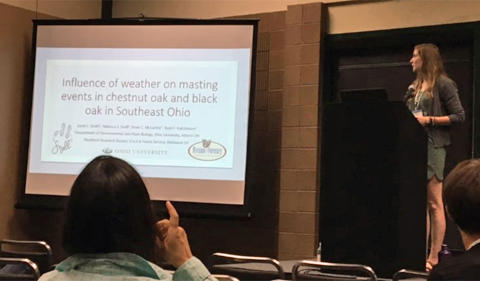Dr. Rebecca Snell, Assistant Professor of Environmental & Plant Biology, and graduate student Sarah Smith presented their research at the 2018 Ecological Society of America, Aug. 5-10 in New Orleans.
Snell presented a talk titled “Climate change impacts on forests and forest productivity at a regional scale” with co-author Harald Bugmann (ETH Zurich).
Abstract: Forests provide a range of ecosystem goods and services (EGS). However, their ability to continue to provide these EGS under a changing climate remains uncertain. While forest managers are encouraged to consider future climate change impacts in their management plans, the tools to aid in this decision-making process are not always available. Regional environmental differences and species-specific responses to climate need to be explicitly considered. Scotland is currently dominated by open landscapes, however there is strong political motivation to increase the amount of forest cover. The main EGS of interest are timber production, carbon sequestration and forest restoration. To understand which tree species would be most suitable under future climate change, we ran a process-based forest gap model for all of Scotland. We simulated monocultures of the three most popular timber trees (i.e., Sitka spruce (Picea sitchensis), Scots pine (Pinus sylvestris) and Douglas fir (Pseudotsuga menziesii)), as well as one simulation of potential natural vegetation (PNV). We used seven GCM-RCM model chains (three RCP 4.5 and four RCP 8.5) to simulate a range of mild to extreme climate change impacts.
In general, climate change had mostly positive impacts on forest productivity however differences in regional patterns depended on the species. Sitka spruce increased in volume (up to 300 m3 ha-1) in the lowlands, while the highlands mostly remain unsuitable for this species under all climate change scenarios. However, warmer winter temperatures in some lowland areas (e.g., in the south and along the west coast) experienced reduced natural regeneration, due to the chilling requirement not being met. Scots pine, which grows well in most of Scotland under current conditions, would experience a decrease in growth under all climate change scenarios (up to a loss of ~70 m3 ha-1). Douglas fir was simulated to have very high productivity (between 400 to 500 m3 ha-1 in as little time as 40 years) under current conditions. Under all climate change scenarios, the highlands and lowlands become increasingly suitable for Douglas fir. Increased growth and productivity for some species (and in some locations) was found even under the most extreme warming scenarios. Understanding these regionally and species-specific differences will help managers prepare for an uncertain future.
Smith presented a talk titled “Influenced of weather on masting events in chestnut oak and black oak,” with co-authors Snell, Dr. Brian McCarthy and Todd Hutchinson (USDA Forest Service).
Abstract: Oak trees are considered foundation species in forests throughout the eastern United States, as they provide essential pulses of food resources to wildlife populations through masting events. Masting events are the synchronous and highly variable production of fruit within a population. Although several hypotheses have been proposed to explain why masting evolved in plants as a reproductive strategy, the factors that trigger any particular mast event are still not well understood. This is partly due to the lack of sufficient long-term data (i.e., even a 10-year study may only have 2 or 3 mast events). As this is a population-level event, weather-related variables are thought to play an important role for triggering a mast event.
Thus, the goal of this study was to analyze the link between weather variables and masting events in black oak (Quercus velutina Lam.) and chestnut oak (Quercus montana Willd.) in southeast Ohio. Cues for masting are expected to differ between the species, as black oaks take two years to mature their acorns, while chestnut oak mature their acorns within a single season. We used data from a long-term study, which followed acorn production of seventy-two black oak and seventy-two chestnut oak trees for sixteen years.
Preliminary analyses found that spring temperature and spring precipitation of the current year had strong positive associations for predicting the probability of a mast event, for both chestnut oak and black oak. Increasing spring temperatures and spring precipitation increased the likelihood of masting for both species. Humidity and wind speed variables had no significant impact on the probability of masting events for either black oak or chestnut oak. These results support previous studies, in that spring weather conditions are critical to the maturation of acorns. Identifying the connection between weather and mast events is vital for predicting future mast events, and for understanding how food resources for wildlife populations may be impacted under climate change.





















Comments